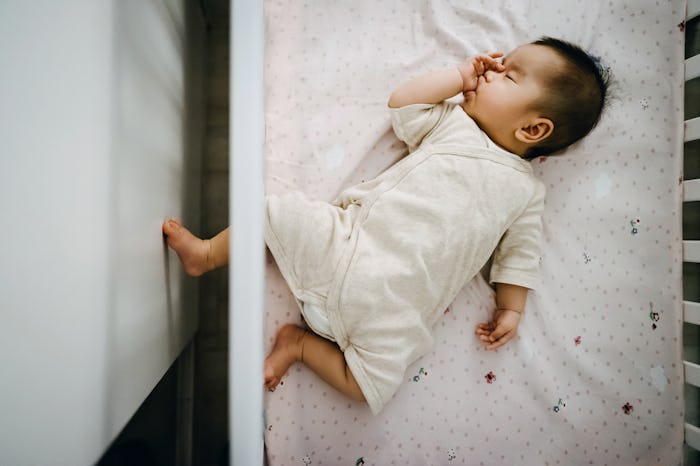Life

Blackout Curtains May Help Baby Sleep Better, But Not Until This Age
When you’re in the throes of the newborn, sleep-deprived stage, you’ll do almost anything for even just a couple of hours of solid Zzzs. And while singing, swaying, and even letting your baby snooze on your chest might get your baby to bed, there may be another option that has less to do with dancing and more about your décor. As sunlight streams through your windows, you might wonder whether or not blackout curtains are good for helping baby sleep.
To understand why blackout curtains might help your baby sleep better, it’s important to understand how sleep cycles work in the first place. As Eva Klein, a certified infant and child sleep consultant tells Romper in an email interview: “Light suppresses the production of melatonin, which is the hormone that makes you sleepy. And when there's too much light shining into the room, it makes falling asleep and staying asleep much more challenging.” Essentially, light is a stimulant, and by using blackout curtains, you’ll be setting the scene for better slumber.
Blackout curtains also helps your night owl understand the difference between daytime and bedtime. “Every night we go through cycles of sleep, and at the end of each cycle, we are drowsy but awake,” says Dr. Poston. “We unconsciously check the environment before returning to sleep.” So if the lights are on, your kiddo is going to assume that it’s time to get up — even if it’s only 4:00 a.m.
But it’s not just babies that benefit from a dark bedroom. In fact, any child (and yes, even adults) snooze better when it’s lights out. “Babies and children of all ages sleep best when the environment is the same when they wake-up from a sleep cycle as it was when they went to sleep,” Dr. Leann Poston M.D., M.B.A., M.Ed., a medical doctor tells Romper in an email interview. “If babies are put to bed in a semi-dark room in their crib, as long as the room stays that way, they will sleep at their best.”
The thing is, blackout curtains work best at specific stages of development, after the newborn stage. “Around 4-5 months old, the baby’s circadian rhythms (internal sleep clocks) begin to develop and sleep becomes more predictable and patterns emerge,” Kaylee Woodard, a certified infant and child sleep consultant and pediatric and NICU occupational therapist, tells Romper in an email. “At that point, the absolute absence of light helps signal the body to produce melatonin- our natural sleepy hormone.” So seeing natural sunlight in the morning (and being in a very dark room at night) can help your baby develop their circadian rhythm to produce the melatonin necessary for solid sleep.
If you’re looking for a way to get your child to fall asleep, blackout curtains might be a wise investment. That way, it’ll be lights out for all of you.
Sources:
Eva Klein, JD, a certified infant and child sleep consultant
Dr. Leann Poston, M.D., M.B.A., M.Ed., a medical doctor
Kaylee Woodard, OTR/L, a certified infant and child sleep consultant and pediatric and NICU occupational therapist